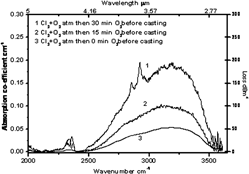Crossref Citations
This article has been cited by the following publications. This list is generated based on data provided by
Crossref.
Boivin, Mathieu
El-Amraoui, Mohammed
Poliquin, Simon
Vallée, Réal
and
Messaddeq, Younès
2016.
Advances in methods of purification and dispersion measurement applicable to tellurite-based glasses.
Optical Materials Express,
Vol. 6,
Issue. 4,
p.
1079.
Strutynski, C.
Mouawad, O.
Picot-Clémente, J.
Froidevaux, P.
Désévédavy, F.
Gadret, G.
Jules, J.-C.
Kibler, B.
and
Smektala, F.
2017.
Optical aging observation in suspended core tellurite microstructured fibers under atmospheric conditions.
Optical Fiber Technology,
Vol. 38,
Issue. ,
p.
154.
Richards, Billy D. O.
and
Jha, Animesh
2017.
Technological Advances in Tellurite Glasses.
Vol. 254,
Issue. ,
p.
101.
Huang, Bo
Xu, Changfu
Zhang, Zhen
Zang, Chun yang
and
Sun, Lizhong
2018.
Removal of hydroxyl routes enhancing 2.85 μm mid-infrared luminescence in oxyfluorotellurite glass with high ZnF2 content.
Journal of Non-Crystalline Solids,
Vol. 502,
Issue. ,
p.
97.
Wang, W.C.
Zhou, B.
Xu, S.H.
Yang, Z.M.
and
Zhang, Q.Y.
2019.
Recent advances in soft optical glass fiber and fiber lasers.
Progress in Materials Science,
Vol. 101,
Issue. ,
p.
90.
Hongisto, M.
Veber, A.
Boetti, N.G.
Danto, S.
Jubera, V.
and
Petit, L.
2020.
Transparent Yb3+ doped phosphate glass-ceramics.
Ceramics International,
Vol. 46,
Issue. 16,
p.
26317.
Désévédavy, Frédéric
Strutynski, Clément
Lemière, Arnaud
Mathey, Pierre
Gadret, Grégory
Jules, Jean‐Charles
Kibler, Bertrand
and
Smektala, Frédéric
2020.
Review of tellurite glasses purification issues for mid‐IR optical fiber applications.
Journal of the American Ceramic Society,
Vol. 103,
Issue. 8,
p.
4017.
Zhang, Zhen
Zheng, Cheng
Wang, Yu
Pei, Jintao
Sun, Lizhong
and
Xu, Changfu
2020.
Removal of hydroxyl groups to enhance the near- and mid-infrared emission of heavy-metal oxyfluoride glasses by chemical clarification : Nitrate ions.
Journal of Non-Crystalline Solids,
Vol. 544,
Issue. ,
p.
120165.
Zheng, Cheng
Li, Jiaxin
Liu, Ying
Sun, Lizhong
and
Xu, Changfu
2021.
High temperature clarifier sulfate enhancing the infrared emission of Oxyfluorosilicate glass ceramics containing CaF2 nanocrystals.
Journal of Non-Crystalline Solids,
Vol. 561,
Issue. ,
p.
120753.
Seshadri, M.
Bell, M.J.V.
Anjos, V.
and
Messaddeq, Y.
2021.
Spectroscopic investigations on Yb3+ doped and Pr3+/Yb3+ codoped tellurite glasses for photonic applications.
Journal of Rare Earths,
Vol. 39,
Issue. 1,
p.
33.
Shearer, Adam
Hauke, Brittney
Montazerian, Maziar
and
Mauro, John C.
2023.
A critical review of infrared transparent oxide glasses.
Optical Materials: X,
Vol. 20,
Issue. ,
p.
100258.
Jamalaiah, B.C.
Rasool, Sk. Nayab
Rao, K. Venkata
Pavani, K.
Soares, M.J.
and
Viswanadha, G.
2024.
Sensitizing effect of Yb3+ ions on 1.53 µm broadband and 548nm upconversion green emissions of Er3+-doped TeO2–WO3–GeO2 glasses.
Materials Research Bulletin,
Vol. 171,
Issue. ,
p.
112628.



